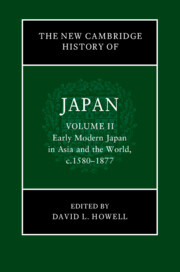Book contents
- The New Cambridge History of Japan
- The New Cambridge History of Japan
- The New Cambridge History of Japan
- Copyright page
- Contents
- Figures
- Maps
- Tables
- Contributors to Volume II
- Preface
- Frontispiece
- Introduction
- Part I The Character of the Early Modern State
- PART II Economy, Environment, and Technology
- Part III Social Practices and Cultures of Early Modern Japan
- Index
- References
Part I - The Character of the Early Modern State
Published online by Cambridge University Press: 15 January 2024
- The New Cambridge History of Japan
- The New Cambridge History of Japan
- The New Cambridge History of Japan
- Copyright page
- Contents
- Figures
- Maps
- Tables
- Contributors to Volume II
- Preface
- Frontispiece
- Introduction
- Part I The Character of the Early Modern State
- PART II Economy, Environment, and Technology
- Part III Social Practices and Cultures of Early Modern Japan
- Index
- References
Summary

- Type
- Chapter
- Information
- The New Cambridge History of Japan , pp. 13 - 226Publisher: Cambridge University PressPrint publication year: 2023

